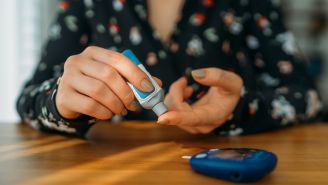Updated on November 7, 2023.
If you have diabetes, planning meals may feel at times like a walking on a tightrope. You can eat this, but not that. You can have some of this, but none of that.
To help make things easier for you, we spoke with Francine Pack, RD, CDE, a certified diabetes educator with Good Samaritan Hospital in San Jose, California, to give us the lowdown on some of the most and least healthy foods for your diet.
Fats
Should we ban all fats from your diet? Don’t think of it. Some fats—such as monounsaturated and polyunsaturated fats found in plant foods and seafood—can help lower cholesterol levels and protect heart health.
Fats to forget, on the other hand, include saturated and trans fats, found in animal products and shortening.
“Saturated fats increase levels of LDL,” Pack says. (LDL, or low-density lipoprotein, is known as "bad" cholesterol.) “There’s also a lot of research around saturated fats increasing insulin resistance,” she says.
To increase your intake of healthy fats, stock your pantry and fridge with foods including:
- Avocado
- Nuts like pecans, peanuts, walnuts, and almonds and nut butters
- Olive and canola oil
- Pumpkin and sunflower seeds
- Fatty fish, such as salmon and albacore tuna
Food high in saturated fats to avoid include:
- Butter and lard
- Cream sauces
- High-fat red meats, such as 20 percent fat ground beef, T-bone steaks, ribs, pork shoulder roast, and pork chops
- Processed meats, such as hot dogs and sausage
- Whole-fat dairy products
Dairy is an excellent source of calcium and protein, but remember to stick with low-fat and nonfat dairy products. Pack notes that if you’re used to whole milk, it can be a shock to your taste buds to make the switch, so do it gradually. “Go from whole to 2 percent first, or try mixing whole milk with 2 percent before getting down to 1 percent,” she says.
Fruits
“All fruits are healthy, high in fiber, and provide important nutrients you’re not going to get in other foods,” says Pack. The key: portion control. “Half a banana has as much carbs as three-quarters of a cup of mandarin orange segments or one cup of raspberries, which is considerably more food to eat,” she says. “It’s not that you shouldn’t eat a banana or kiwi, it’s how much you eat at one time.” While dried fruits can be a healthy choice for most people, the recommended portion size is tiny and can be hard to limit, she adds.
Your best best among fruits include:
- Fresh fruits
- Frozen fruits
- Canned fruits in their own juice or water
Fruits and fruit products to avoid include:
- Canned fruits with added sugar or in syrup
- Fruit juice or punch with added sugars
- Jam, jelly, and preserves
- Dried fruits with added sugars
Vegetables
Like fruit, vegetables are rich in vitamins, minerals, and fiber and low in calories. But not all veggies are alike when it comes to diabetes. Non-starchy vegetables, like broccoli, tomatoes, and carrots, are low in carbs. But starchy vegetables (think potatoes and corn) are one of the main sources of carbohydrates, so carb counters should eat them in moderation.
Good veggie options include:
- Fresh vegetables served raw, steamed, roasted, or grilled
- Dark, leafy greens like kale, collards, and spinach
- Steamed frozen vegetables
- Canned vegetables low in sodium
- 100-percent vegetable juice (look for low or reduced sodium)
Veggies to avoid include:
- Canned or frozen vegetables with added sodium, fat, or sugar
- Vegetables cooked with butter or creamy sauces
Beans and legumes are another great carbohydrate source. While high in fiber, vitamins, and minerals, this filling carbohydrate is also high in protein, making it a good substitute for other protein sources, such as red meats. Just remember to include them in your carb counting.
Grains
When it comes to grains, whole grains are the most nutritious—full of vitamins, minerals, and fiber. “Whole wheat, high fiber, and less-processed foods provide the best response on blood sugar and are the healthiest for you,” Pack says. But buying whole grain foods can be tricky. The package may tout "whole grain" as an ingredient, but it may be a small amount. For a true 100-percent whole-grain food, the whole grain should be listed first on the nutrition label.
Best bets include:
- Bread, crackers, and pasta made with 100-percent whole-wheat flour
- Oatmeal
- Bran cereal
- Brown and wild rice
- Quinoa
- Bulgur
- Whole-grain barley
- Popcorn
Grain foods to avoid include:
- Foods such as bread, pasta, cereal, and crackers made with refined grains
- Instant rice or instant noodles
Plan your plate
Now that you know what to choose—and what to skip—it's time to plan your plate. Here's a simple formula:
- Fill half of your plate with non-starchy veggies.
- Fill a quarter of the plate with whole grains like brown rice and quinoa, or starchy veggies like corn and potatoes.
- Fill the remaining quarter with a lean protein such as chicken, fish, or beans.
- Add a serving of fruit or dairy (or both) as your meal plan allows.






